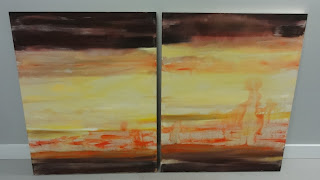Issues:
Developing wet into wet
paintings (acrylic on paper).
Discussion with Lothar who reckoned that vertical format single brush expressions were little more than mark making and it is difficult to imbue much content.
However, experiment with more marks so that paint rather than 'space' dominated the ground.
Composition also an issue - often more effective to co-opt an actual structure rather than invent from a 'blank canvas'.
LG suggests trialing acrylic directly onto unprimed canvas. Also discuss with Virginia and it seems there are two schools of thought as to the most effective technique:
1) directly on to unstretched canvas laid horizontally
2) using very taught stretched canvas.
Initial trial using unstretched canvas
Canvas thoroughly wetted to ensure uniform moisture content
Acrylic also fairly diluted to help acheive a 'suffused backgrround'
Initial results indicate unstable uptake of pigment where it is very difficult to predict / control the result.
Results left show continuing bleeding and loss pigment colour.
Lower picture taken one hour after top picture
Two trial panels
Shows limited and unpredictabe uptake of pigment

































